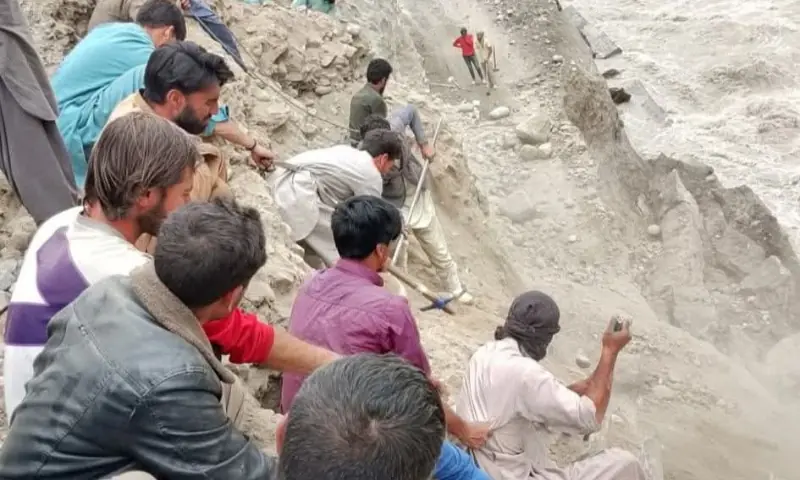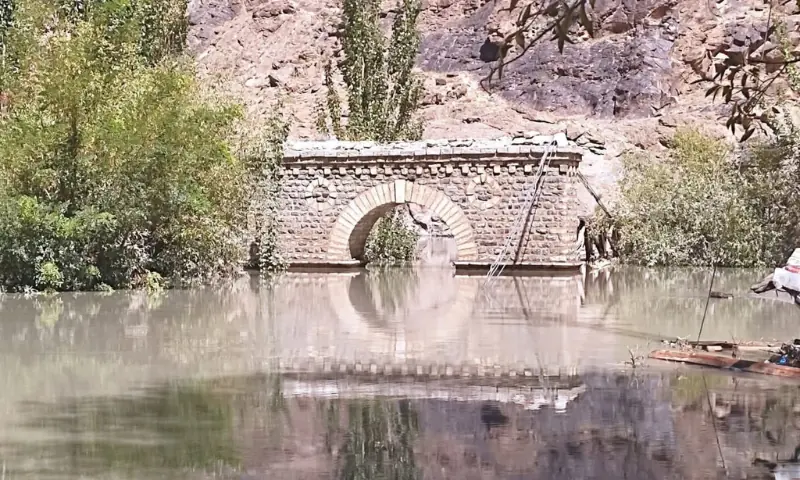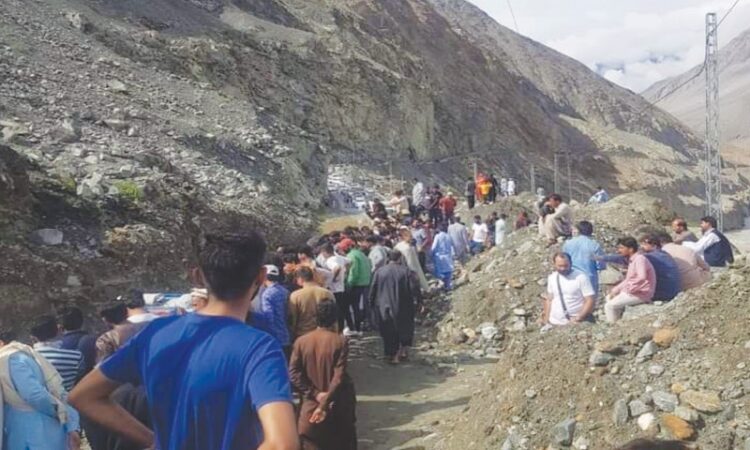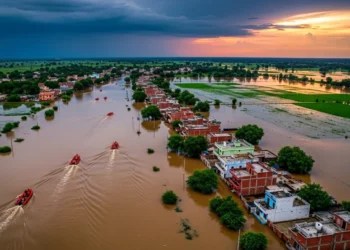GILGIT; Several parts of Gilgit-Baltistan’s (GB) Ghizer district have remained cut off for five consecutive days, with authorities racing to clear the Gilgit-Shandur road after devastating floods and landslides triggered by monsoon rains.

Since late July, heavy downpours have wreaked havoc across Pakistan, particularly in northern mountainous regions like GB, where glacial lake outburst floods (GLOFs) and landslides have displaced communities, destroyed homes, and crippled essential infrastructure. Poor drainage systems and densely populated valleys have further intensified the damage.
Communities Cut Off
According to local accounts, major tehsils including Gupis, Phander, and Yasin have been stranded for nearly a week. In Raushan village, a massive artificial lake formed by glacial floods submerged a five-kilometre stretch of the Gilgit-Shandur road, cutting off the main artery linking the region.

Local resident Meraj Ali Shah newsmen that at least 300 houses have been damaged by the flooding, with entire villages such as Hakis, Thangi, and Raushan submerged. “Hundreds of people have been displaced after a GLOF swept through Tildas village,” he said. “They are surviving without electricity, drinking water, shelter, or medical facilities.”
Residents accused the government of failing to provide timely assistance, claiming that relief supplies were arriving primarily through welfare organisations. Two critically ill patients from Gupis were airlifted to Gilgit on Monday with the help of the Aga Khan Development Network.
Long-Term Isolation
The devastation is not limited to Ghizer. For nearly three weeks, the Karakoram Highway at Hassanabad, Hunza, has remained blocked after floods from the Shishper glacier submerged a major section of the road. The closure has caused immense hardship for residents, while dozens of homes, farmlands, and public infrastructure in the area have been destroyed.

In Nagar district’s Hisper valley, residents have been isolated for over a month due to river erosion and landslides, while valleys in Gilgit’s Haramosh and Bagrot areas remain disconnected. Essential water supply systems serving thousands of people in Gilgit’s Danyor, Sultanabad, and Mohammadabad have also collapsed. Locals reported that families have been forced to purchase water tankers daily, an expense that poorer households cannot afford.
“For the last month, residents have faced an acute water crisis. Crops and fruit trees are drying up due to the absence of irrigation channels,” said Shahzad Hussain, a local farmer.
In Baltistan’s Ghanche district, more than 60 households displaced in Mashabrum’s Haldi and Balayagan villages are living in tents under the open sky. “The government has not taken concrete steps for rehabilitation, leaving people in a state of helplessness,” said another resident, Muhammad Alam.

Psychological Toll and Relief Efforts
The GB government admitted in a statement on Tuesday that the recent disasters have caused not only physical destruction but also mental trauma, particularly among children, women, and the elderly.
A high-level meeting chaired by Additional Secretary of Social Welfare Arif Tahseen was held to develop a coordinated mental health response. Officials from the Health Department, Aga Khan Health Service, and Rupani Foundation agreed to collaborate on psychological rehabilitation, awareness campaigns, and the provision of trained psychologists in affected areas.
Tahseen emphasized that disaster response must address both physical needs and long-term emotional impacts. “The floods have left deep scars. Without mental health support, recovery will remain incomplete,” he said.
Government Response
Gilgit-Baltistan Disaster Management Authority (GBDMA) Director General Zakir Hussain said machinery from the National Highway Authority had been deployed to clear the Gilgit-Shandur road. He added that an alternative bypass road with a connecting bridge has been approved and is under rapid construction.
“The government is utilizing all available resources in coordination with institutions to restore normalcy. We stand with the affected people,” Hussain assured.
Meanwhile, Prime Minister Shehbaz Sharif is scheduled to visit GB on Wednesday to personally assess the situation. Ahead of his arrival, GB Chief Secretary Abrar Ahmed Mirza chaired a preparatory meeting, where officials reviewed flood damages, ongoing rehabilitation efforts, and the functionality of early warning systems. He instructed authorities to accelerate relief work and ensure coordination among all departments before the PM’s visit.
A Region in Crisis
While local communities are showing resilience, the sheer scale of destruction highlights the vulnerabilities of GB, a region at the frontline of climate change. With its fragile mountain ecosystems, growing glacial instability, and underdeveloped infrastructure, the area remains prone to recurring disasters. For now, thousands remain stranded, struggling to survive without basic necessities as they await meaningful and sustained government support.
























